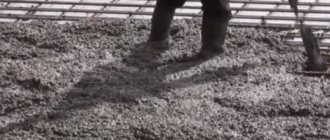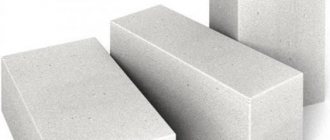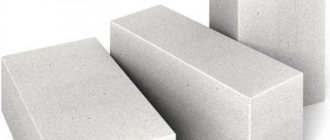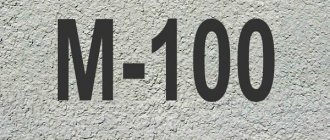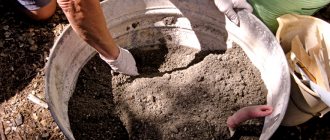Cement M500 without additives. Photo by YuzhUralPBK
Cement is one of the main building materials . Therefore, manufacturers produce a whole range of types and brands, differing in composition and characteristics : strength, hardening speed, resistance to various types of influences, etc., and, accordingly, in the scope of application. Each brand of cement has its own recommendations for use.
What does this mean, what does it depend on
Information about the brand of cement is included in the designations on the packaging. Today, cement marking is carried out in accordance with GOST 2003 , edited in 2016. Both versions of the document are valid and comply with the requirements adopted in European countries. In accordance with this state standard, the brand is not indicated; there is a designation of strength class , measured in megapascals (MPa). Each strength class corresponds to a specific brand:
- 7.5 - M100;
- 15.0 - M200;
- 22.5 - M300;
- 32.5 - M400;
- 42.5 - M500;
- 52.5 - M600.
The marking begins with the letters “CEM” - on packages made in Russia and “CEM” - on foreign made ones; the Roman numerals following them indicate the type of material:
| Designation | Type of binder | Note | |
| CEM I | Portland cement | Does not contain mineral additives | |
| CEM II | Portland cement with mineral additives | The letters indicate the subtype, which characterizes the percentage of additives | |
| CEM III | Slag Portland cement | ||
| CEM IV | Pozzolanic | ||
| CEM V | Composite |
The type and quantity of additives are also indicated. The letter after the fraction shows the content of additives as a percentage : A - 6-20; B - 20-35 and C - more. A hyphen indicates the type of additive: limestone, ash, microsilica, shale, slag.
Despite the new standards, it is possible to find old-style designations . In accordance with previous requirements, cement was labeled briefly , indicating the composition and strength of the material, the percentage of additives and special properties. The composition of the cement was a group of capital letters: Portland cement - PC, slag Portland cement - ShPTs, white cement - BC, etc. Then the marking contains numbers indicating the compressive strength (in kg/sq.cm.), which the concrete reaches after 28 days: 300, 400, 500, etc. The letter “D” with numbers following the strength indicator indicates the amount of additives, varying from 0 to 20%. The last letters indicate special properties: N - normal-hardening or B - fast-hardening; PL - plasticized; GF - has hydrophobic properties.
What brands are there in terms of strength and their application, the highest, class
M100
Despite its low characteristics, M100 cement is used in individual and commercial construction . The main reason for its demand is low cost . In addition, it is possible to increase the strength of concrete mortar using plasticizers. Mortars made on the basis of M100 cement are suitable for finishing, plastering and repair work, arranging floor screed at the initial stage of rough work, doing brickwork, leveling walls, in particular, filling potholes, for rough road work. Internal work must be carried out in dry rooms. If the environment is characterized by high humidity, then the proportion of cement in the solution must be increased.
M150
M150 cement can withstand a maximum load of 150 kg/sq.cm. Despite the low characteristics, the binder of this brand is in fairly high demand. Cement-sand mortars based on M150 binder have the following advantages:
- The ability to create an even layer, which is convenient both in the process of plastering and in the process of laying walls.
- No cracks or chips form on the surface of the frozen solution if no mistakes were made during the preparation of the mixture.
- The density when hardened is uniform over the entire application area.
- High frost resistance allows you to perform work in most regions of Russia.
Dry cement. Photo by LafargeHolcim
Mixtures based on M150 cement are characterized by environmental safety, resistance to high temperatures, plasticity, ease of application, hardening occurs quite quickly (after 40-60 minutes), so work must be carried out promptly. Mortars are used for laying walls made of stone, brick and blocks, for plastering, they are suitable for interior and exterior work. The solutions contain small particles of filler, which makes the surface of the walls even and smooth.
Before performing work, it is necessary to prepare the working surface in order to clean it from dust, dirt and foreign elements. Mixing the dry mixture with water is carried out until a completely homogeneous mixture is obtained; for this, a mixer or a special construction drill is used.
M200
The basis for the production of M200 cement is clinker with a significant proportion of silicates . The technology for producing the binder does not differ from the method for producing higher grades of cement. The only difference is the larger amount of gypsum and other additives added to the raw materials and influencing the characteristics. Binder M200 is used for the preparation of cement-sand mortars , which find applications:
- for laying bricks and small wall blocks, interior and facade tiles, self-supporting structures;
- for arranging floor screeds in heated and unheated public premises;
- for paving sidewalks and garden paths;
- for preparing weak concrete for the formation of foundation cushions;
- for the production of repair mixtures for restoration and repair work on concrete and reinforced concrete structures, in particular, sealing seams and cracks;
- for the preparation of plaster mortars used for finishing internal and external walls, as a rough or finishing layer.
Paved path. Photo by LafargeHolcim
Thus, cement is mainly aimed at performing small-scale construction and household works. It will be useful for individual performers implementing ideas at home to learn some recommendations for working with cement:
- dry cement powder must be added to clean cold water, but not vice versa;
- The cement mixture must be diluted mechanically using a construction mixer or a drill with an attachment until a mass with a homogeneous consistency is obtained, avoiding clumping;
- the holding time of the solution should not exceed 5 minutes , then the solution should be mixed again;
- the first setting time occurs after 2 hours , gaining full strength takes 28 days;
- The solution should be applied to a previously prepared surface at a temperature not lower than +5 degrees Celsius.
In addition, when working with M200 binder you should remember:
- the mobility of the solution is maintained during the setting process;
- the thickened solution is unsuitable for use;
- When working with cement of any brand, you must avoid getting the mixture in your eyes, so personal protective equipment is required.
M250
This brand of cement is used:
- for the construction of structures experiencing light loads;
- for producing cement and cement-lime, complex masonry mortars;
- for installing a roofing felt base;
- for creating elements of prefabricated structures;
- for the manufacture of reinforced concrete structures exposed to elevated temperatures and moisture, but are not suitable for exterior finishing.
M300: 50 kg. And so on
M300 cement is one of the most popular types of binder. A distinctive characteristic is the slow increase in strength. Setting time is at least 75 minutes. The uniformity of expansion does not exceed 10 mm. The list of consumers includes individuals, manufacturers of concrete products, repair and construction companies. Cement has sufficient strength (22.5 MPa or 300 kg/sq.cm.) to solve a wide range of problems:
- preparation of mixtures for pouring foundations of various types;
- installation of floor screeds in industrial and utility premises;
- preparation of mixtures used for masonry, cladding, plastering, sealing interpanel seams and other finishing works;
- production of prefabricated concrete products and hydraulic structures;
- preparation of concrete mixtures for the construction of road surfaces.
Sand concrete. Photo by LafargeHolcim
There are some recommendations for performing individual work:
- The generally accepted ratio of cement and sand when performing plastering work is 1 to 3, respectively . Therefore, it is possible to control the consistency. When carrying out facade plastering work, it is possible to introduce lime into the solution in the amount of 0.5 parts to 1 part sand, which will make the mixture plastic. This allows the mixture to be applied in a thinner layer.
- When laying bricks, the ratio is 1 part cement and 4 sand. It is possible to dilute the components with slaked lime in a proportion of 0.2 parts to 1 part cement, which makes the solution more plastic and pliable. You can test the resulting solution by tilting the container with it at an angle of 40 degrees. If the mixture does not flow out of the container, but stretches, then everything is done correctly.
Cement and sand concrete grades are sold in bags of various sizes, the most popular are 25 and 50 kg, big bags and in bulk.
M350
M350 grade cement is not produced. By mixing Portland cement M400 and higher, sifted sand of any fraction or crushed stone, water, and additives, it is possible to prepare M350 concrete. It has increased strength, high density and mobility, and a long service life of the monolith. Therefore, it is used for arranging slab and strip foundations for massive buildings and heavy machines, for the production of prefabricated concrete products subjected to significant loads: columns, crossbars, beams, trusses, floor slabs, etc., for concreting supports of pile-grillage foundations.
M400, 32.5B, 32.5N
Cement M400, along with grade 500, is the most popular category of binder. The M400 was mainly used in residential and civil construction . Strength allows the use of cement in the construction of above-ground and underground facilities . M400 is used for the preparation of concrete, mortars for plastering and bricklaying , and the production of reinforced concrete structures. In accordance with the new standards, the M400 grade corresponds to strength class 32.5. Companies produce an extensive list of types of M400 cement, in particular, fast-acting, marked 32.5B, and normal-acting, 32.5N.
Cement. Photo Petrovich
M450
This brand of cement is not available from manufacturers, but it is possible to provide information about M450 concrete . To prepare the solution you will need cement grades M400 or M500 , purified sand without impurities, it is recommended to give preference to river sand, granite crushed stone of different fractions, which can provide high strength to the concrete structure, and water. Additives are used to increase the strength, frost and water resistance of the solution. Concrete has a significant margin of safety , therefore it is used to solve critical problems; it is not used in private construction. Concrete is used for the installation of runways and hydraulic structures, construction of bridge supports, construction of tunnels and metro stations, arrangement of bomb shelters and bunkers.
M600: characteristics, what it is used for and more
Cement is used to prepare concrete M500 , which, due to its high strength, was called “military” , which directly indicates the scope of application. Most often it is used in the construction of military facilities and other special structures. Cement is practically not used in the construction of concrete and monolithic structures , or for the production of general-purpose reinforced concrete products. The reason is rapid hardening and high strength . These features allow the binder to be successfully used during emergency and restoration work. Products are effective when carrying out reconstruction work.
Under normal conditions, setting begins after 45 minutes and is completed after 10 hours. The flexural and compressive strengths are 6.4 and 58.8 MPa , respectively. The high level of resistance to moisture and fire makes the brand the best option in construction, in situations where it is necessary to ensure the best quality and reliability. There are several types of M600 cement:
- PC is ordinary Portland cement, the properties of which are important in various fields: implementation of restoration and emergency work, during reconstruction and elimination of defects;
- BC - white cement is used for decorative purposes; it is possible to create a variety of structures from it and perform finishing work, painting the mixture in any color;
- BTC - quick-hardening is used for urgent emergency work;
- ShPC is Portland slag cement, which, in addition to crushed clinker, contains granulated blast furnace slag in an amount of 30-65%; products made from ShPC resist high temperatures, but harden slowly;
- VRC is a waterproof, expanding type, the properties of which are presented in the name, used for sealing seams in hydraulic structures, suitable for eliminating leaks in ship hulls.
- SS - sulfate-resistant resists the effects of salt water and other harmful environments with a high content of sulfates.
M700
M700 cement is not found on sale very often. It is indispensable for the implementation of important tasks during the construction of buildings that have special requirements for strength, resistance to moisture, mechanical and aggressive influences. It is also used when there is a need for prompt repairs and restoration of buildings. The binder is often used for the manufacture of reinforced concrete structures, the construction of foundations for high structures, powerful buildings and equipment, in bridge construction, etc.
The characteristics of cement demonstrate its superiority over the brands presented above . The M700 binder is distinguished by its composition of components, which provides significant strength to concrete and short hardening times, high resistance to moisture, ultraviolet radiation and sudden temperature changes, as well as the formation of cracks, and excellent ductility. Of interest is white cement M700, which is quite rare, but is capable of creating a completely smooth surface, which allows it to be used for arranging self-leveling floors and making decorative elements.
M800
M800 refers to fast-hardening high-strength cements . Concrete based on BTC 800 has the following characteristics :
- accelerated period of hardening and hydration , setting begins after the dry components react with water (approximately 45 minutes) and is completed after 6 hours; It gains brand strength within 18-24 hours.
- reduced water consumption in the process of preparing solutions with the same mobility;
- high strength class - B60-100;
- increased sulfate resistance;
- reduced heat generation during hardening;
- resistance to low temperatures.
It is used for the preparation of high-strength mortars and concrete mixtures, which are used for arranging the foundations of buildings and structures, erecting monolithic and prefabricated structures, constructing tunnels in the mining industry and bridge crossings.
M900
M900 also refers to fast-hardening materials ; the setting process at an ambient temperature of +20 degrees and a 1:1 ratio of water to cement begins in 60-120 minutes and ends in 120-150 minutes. Also, the 900th grade is distinguished by high productivity, environmental friendliness and safety, stability, cost-effectiveness, and the ability to use with standard injection equipment.
Cement is used in the construction of underground facilities : tunnels and mines, where excavation injection is used; in the mining industry , where it is impossible to do without sealing to protect against the effects of groundwater; in civil and industrial construction for injection of joints, seams, cracks, contacts. In addition to BTC M900, the sale includes well cement (PTC), used in the construction of bunkers, low-rise construction of strategic facilities and heavy-duty structures, and high-alumina refractory, which successfully solves problems of exposure to significant temperatures.
M1000
Cement is produced without additives or impurities , has unique characteristics, and is used in the construction of especially durable structures . Construction using this material is carried out by large companies. Cement is not used in everyday life , so it is difficult to find it on sale. The reason is the higher cost and rapid setting and hardening, which affects storage. Cement is used in the construction of dams, breakwaters and other hydraulic structures, and is often used in military construction , in the construction of bunkers, bunkers and bunkers. This brand is the highest; in open sources it is possible to find information about cement M2000, but there is practically no information about it.
Composition and proportions of M800 concrete
The composition of concrete M800 includes the following ingredients:
- Portland cement grade M500;
- purified sand;
- high-strength crushed stone;
- plasticizers (for example, based on polycarboxylate);
- Purified water.
To produce M800 B60 concrete mortar, high quality components are used:
- Only quarry sand, thoroughly cleaned and washed to remove clay and other impurities. The size of the grain of sand should be – 2.4 – 2.6 mm.
- Crushed stone based on granite chips with a fraction from 5 mm to 20 mm.
- Pure filtered water, there should be no biological or chemical impurities.
Only high-strength rocks are used as crushed stone filler.
All ingredients must be measured accurately; deviations of even a gram are not allowed. Therefore, in the production of concrete grade 800, automatic equipment is often used, which carefully monitors compliance with the proportions of the main components.
Average proportions of key ingredients:
- Cement 1 part;
- Sand – 0.8 parts;
- Crushed stone – 2 parts.
Considering the production of M800 concrete mixture in a factory and its proportional ratio in kilograms, the following can be obtained:
- Cement – 485 kg;
- Sand – 780 kg;
- Crushed stone – 980 kg;
- Plasticizers – 55 kg;
- Water - 150 liters.
It is necessary to strictly observe the proportions; any deviation will lead to loss of quality of the material.
How to determine, find out, self-determination and in laboratory conditions
The grade of cement is determined in laboratory conditions . Using special equipment, the strength of the sample is determined , to obtain which it is necessary to add 3 purified quartz sand to 1 part of cement
.
The components are thoroughly mixed. Water is added during mixing. The mixture is poured into 6-10 molds with dimensions of 10 by 10 by 10 cm. The samples must be left for 28 days, during which the samples will gain up to 98% of the brand strength. One of the samples is placed under a press and subjected to pressure. The rate at which the sample is destroyed is measured. Measurements are carried out on 6 samples chosen randomly. Of the 6, the 4 with the most significant pressure required for destruction are selected and the average value is calculated. Based on the test results, the brand and strength class are determined.
Cement M500. Roscement Photos
In addition, the brand can be determined at home . For various reasons, the labeling on the packaging may be unreadable . Then recognition can be carried out experimentally . The performer will not receive an exact result, but approximate information will be acquired. To do this, you need to take a hammer and hit the surface of the concrete, or with a hammer, hit a chisel attached perpendicular to the surface of the monolith. If after an impact the concrete breaks into small fragments or large pieces break off from the monolith or the chisel penetrates the concrete to a depth of 5 mm, then this is a fragile M100 grade. If sharp fragments are separated from the monolith, then M100-200. A shallow trace is formed on the surface - M300-400. The strongest possible blow with a hammer on the edge of the structure leads to small fragments breaking off or a mark 1-2 mm deep is formed on the surface. - M400-600.
Features of fast-hardening cement M800
M800 cement is a high-strength hydraulic binder, which is obtained by finely grinding Portland cement clinker and gypsum stone with the addition of a superplasticizer - a special additive designed to reduce the amount of water. Find out how M900 cement is extracted in this article.
The interaction of the minerals of Portland cement clinker with the superplasticizer leads to the fact that the resulting composition acquires specific and unique properties, which is the main distinguishing feature of the material.
Which is better…
Determining the best cement is possible only taking into account the purpose of the building material. For various types of work, certain brands are the best option. Depending on the requirements for strength, moisture and frost resistance, resistance to mechanical and aggressive influences, the best option should be chosen.
for bricklaying
To obtain reliable and durable masonry, the mixture must meet certain requirements:
- Plasticity . Only a plastic mixture qualitatively fills all the voids between the bricks. When performing work at high temperatures, it is recommended to choose a mixture with increased mobility.
- High adhesion to brick . Good adhesion ensures the strength and durability of the entire structure.
- Optimal setting time . Setting too quickly or for a long time complicates the work. The optimal period for maintaining plasticity is 1.5-2 hours.
- High strength after hardening and absence of cracks.
- Waterproof . Seams must be resistant to moisture penetration.
- stability and durability for color mixtures.
Cement. Photo Megastroy
To prepare masonry mixtures, the following are most often used:
- PC M400 D0 or D5 . This brand is suitable for the construction of small houses.
- PC M500 D0 . The mixtures shrink slightly during hardening, which reduces the risk of cracks. PC M500 is used in the construction of buildings experiencing increased loads.
Masonry mortars of different brands are used to solve different problems:
- to produce M50 concrete, only M400 cement is used, which is in demand in low-rise construction and sealing cracks;
- M75 is a universal material for brick and block masonry of partitions and external walls;
- M100 , for the construction of multi-storey residential buildings and industrial facilities;
- M150 , characterized by high strength, is in demand for masonry.
best for concrete
M100 cement is used for the preparation of lightweight concrete used for preparatory work. M200 is used for the production of plaster and masonry mixtures. M300 - for installation work and construction of residential buildings. M400-500 - for the formation of foundations and the production of reinforced concrete structures. M600-1000 - for creating especially strong mortars that are used in the construction of multi-story buildings, bridges, etc.
Cement. Photo Asia Cement
In general, the correspondence between cement and concrete grades can be represented as follows:
- M150 - M300;
- M200 - M300 or M400;
- M250 - M400;
- M300 - M400 or M500;
- M350 - M400 or M500;
- M400 - M500 or M600;
- M450 - M550 or M600;
- M500 - M600;
- M600 and above - M600.
use for the foundation of a private house
For a strip foundation it is required to use M300 cement; for a slab foundation it is recommended to choose M300 or M400; for a columnar foundation - M400. However, to ensure increased reliability and durability, it is recommended to choose a binder of at least M500 grade.

